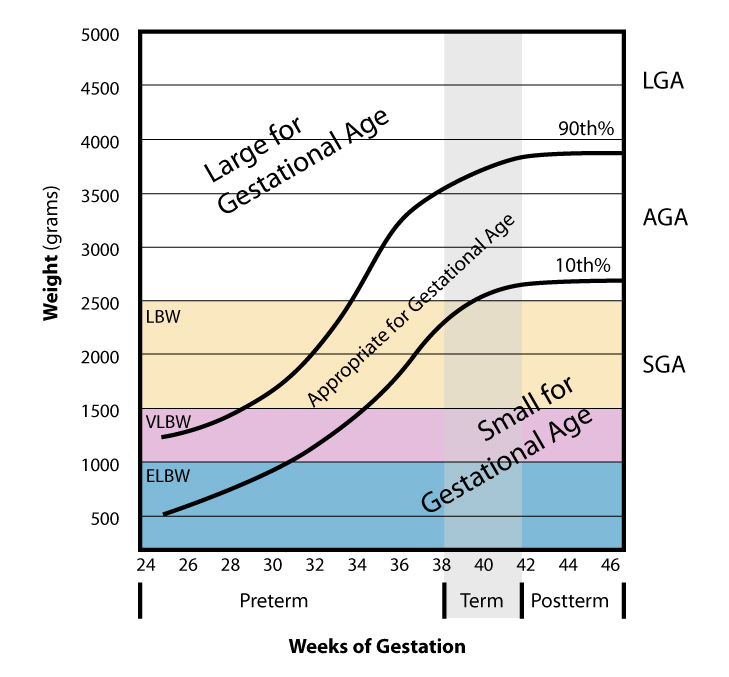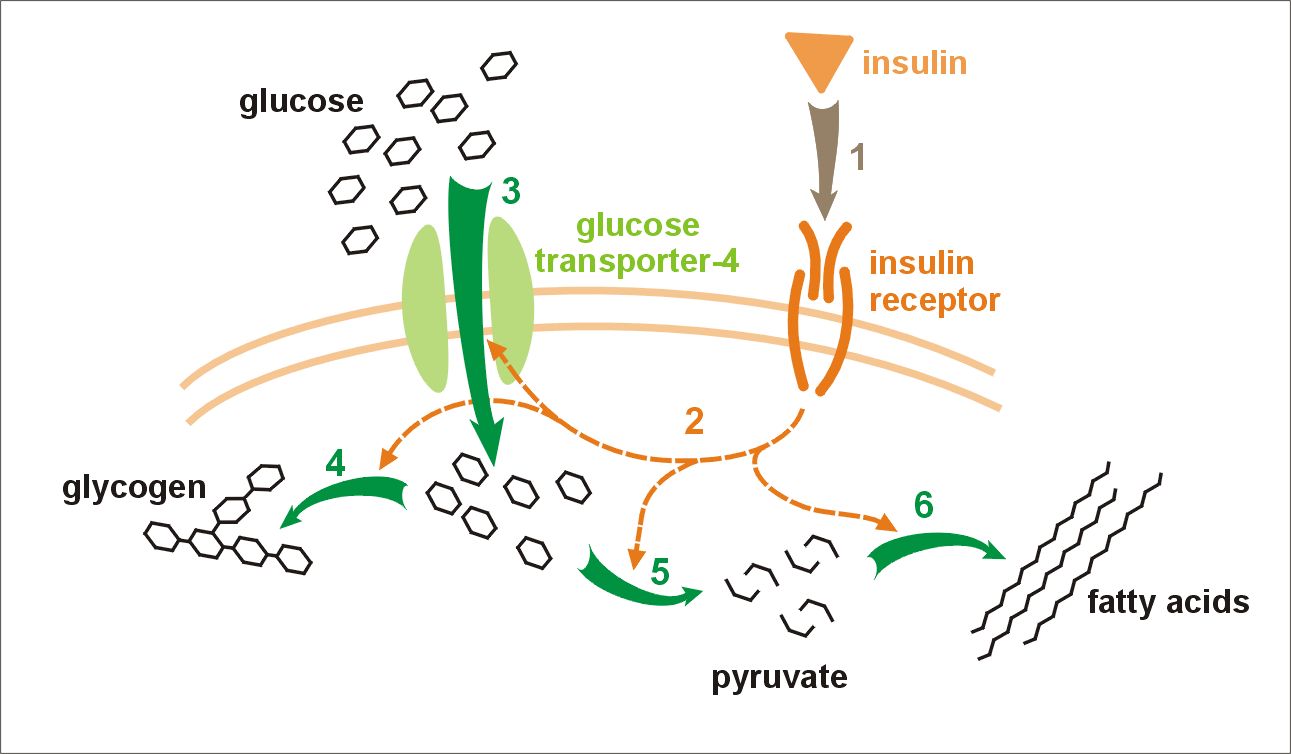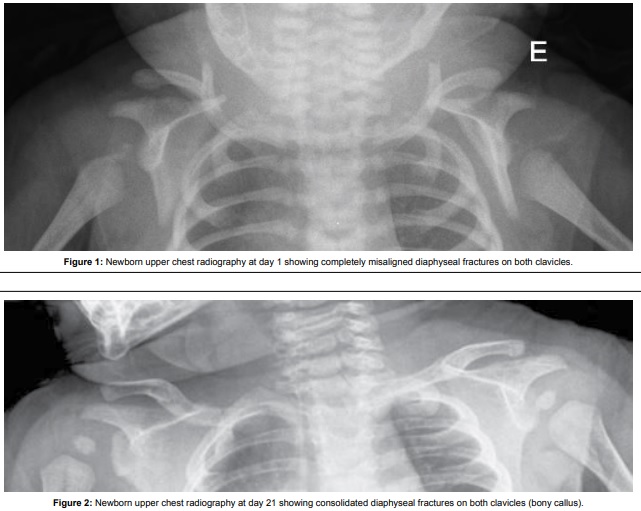|
Macrosomia
Large for gestational age (LGA) is a term used to describe infants that are born with an abnormally high weight, specifically in the 90th percentile or above, compared to other babies of the same developmental age. Macrosomia is a similar term that describes excessive birth weight, but refers to an absolute measurement, regardless of gestational age. Typically the threshold for diagnosing macrosomia is a body weight of between , or more, measured at birth, but there are difficulties reaching a universal agreement of this definition. Evaluating an infant for macrosomia or LGA can help identify risks associated with their birth, including labor complications of both the parent and the child, potential long-term health complications of the child, and infant mortality. Signs and symptoms Fetal macrosomia and LGA often do not present with noticeable patient symptoms. Important signs include large fundal height (uterus size) and excessive amniotic fluid (polyhydramnios). Fundal height ... [...More Info...] [...Related Items...] OR: [Wikipedia] [Google] [Baidu] |
Perlman Syndrome
Perlman syndrome (PS) (also called renal hamartomas, nephroblastomatosis and fetal gigantism) is a rare overgrowth disorder present at birth. It is characterized by polyhydramnios and fetal overgrowth, including macrocephaly, neonatal macrosomia, visceromegaly, dysmorphic facial features, and an increased risk for Wilms' tumor at an early age. The prognosis for Perlman syndrome is poor and it is associated with a high neonatal mortality. Perlman syndrome is an uncommon genetic disorder grouped with overgrowth syndrome in which an abnormal increase is often noted at birth in the size of the body or a body part of the infant. The disorder, also called renal hamartomas, nephroblastomatosis and fetal gigantism, has also been grouped with Renal cell carcinoma. The characteristic features include polyhydramnios, fetal overgrowth, including macrocephaly, neonatal macrosomia, visceromegaly, dysmorphic facial features, and an increased risk for Wilms' tumor at an early age. Signs and symp ... [...More Info...] [...Related Items...] OR: [Wikipedia] [Google] [Baidu] |
Gestational Diabetes
Gestational diabetes is a condition in which a woman without diabetes develops high blood sugar levels during pregnancy. Gestational diabetes generally results in few symptoms; however, it increases the risk of pre-eclampsia, depression, and of needing a Caesarean section. Babies born to mothers with poorly treated gestational diabetes are at increased risk of macrosomia, of having hypoglycemia after birth, and of jaundice. If untreated, diabetes can also result in stillbirth. Long term, children are at higher risk of being overweight and of developing type 2 diabetes. Gestational diabetes can occur during pregnancy because of insulin resistance or reduced production of insulin. Risk factors include being overweight, previously having gestational diabetes, a family history of type 2 diabetes, and having polycystic ovarian syndrome. Diagnosis is by blood tests. For those at normal risk, screening is recommended between 24 and 28 weeks' gestation. For those at high risk, testin ... [...More Info...] [...Related Items...] OR: [Wikipedia] [Google] [Baidu] |
Shoulder Dystocia
Shoulder dystocia is when, after vaginal delivery of the head, the baby's anterior shoulder gets caught above the mother's pubic bone. Signs include retraction of the baby's head back into the vagina, known as "turtle sign". Complications for the baby may include brachial plexus injury, or clavicle fracture. Complications for the mother may include vaginal or perineal tears, postpartum bleeding, or uterine rupture. Risk factors include gestational diabetes, previous history of the condition, operative vaginal delivery, obesity in the mother, an overly large baby, and epidural anesthesia. It is diagnosed when the body fails to deliver within one minute of delivery of the baby's head. It is a type of obstructed labour. Shoulder dystocia is an obstetric emergency. Initial efforts to release a shoulder typically include: with a woman on her back pushing the legs outward and upward, pushing on the abdomen above the pubic bone, and making a cut in the vagina. If these are not effec ... [...More Info...] [...Related Items...] OR: [Wikipedia] [Google] [Baidu] |
Obstetrics
Obstetrics is the field of study concentrated on pregnancy, childbirth and the postpartum period. As a medical specialty, obstetrics is combined with gynecology under the discipline known as obstetrics and gynecology (OB/GYN), which is a surgical field. Main areas Prenatal care Prenatal care is important in screening for various complications of pregnancy. This includes routine office visits with physical exams and routine lab tests along with telehealth care for women with low-risk pregnancies: Image:Ultrasound_image_of_a_fetus.jpg, 3D ultrasound of fetus (about 14 weeks gestational age) Image:Sucking his thumb and waving.jpg, Fetus at 17 weeks Image:3dultrasound 20 weeks.jpg, Fetus at 20 weeks First trimester Routine tests in the first trimester of pregnancy generally include: * Complete blood count * Blood type ** Rh-negative antenatal patients should receive RhoGAM at 28 weeks to prevent Rh disease. * Indirect Coombs test (AGT) to assess risk of hemolytic dis ... [...More Info...] [...Related Items...] OR: [Wikipedia] [Google] [Baidu] |
Diabetes Mellitus
Diabetes, also known as diabetes mellitus, is a group of metabolic disorders characterized by a high blood sugar level ( hyperglycemia) over a prolonged period of time. Symptoms often include frequent urination, increased thirst and increased appetite. If left untreated, diabetes can cause many health complications. Acute complications can include diabetic ketoacidosis, hyperosmolar hyperglycemic state, or death. Serious long-term complications include cardiovascular disease, stroke, chronic kidney disease, foot ulcers, damage to the nerves, damage to the eyes, and cognitive impairment. Diabetes is due to either the pancreas not producing enough insulin, or the cells of the body not responding properly to the insulin produced. Insulin is a hormone which is responsible for helping glucose from food get into cells to be used for energy. There are three main types of diabetes mellitus: * Type 1 diabetes results from failure of the pancreas to produce enough insulin due to lo ... [...More Info...] [...Related Items...] OR: [Wikipedia] [Google] [Baidu] |
Caesarean Section
Caesarean section, also known as C-section or caesarean delivery, is the surgical procedure by which one or more babies are delivered through an incision in the mother's abdomen, often performed because vaginal delivery would put the baby or mother at risk. Reasons for the operation include obstructed labor, twin pregnancy, high blood pressure in the mother, breech birth, and problems with the placenta or umbilical cord. A caesarean delivery may be performed based upon the shape of the mother's pelvis or history of a previous C-section. A trial of vaginal birth after C-section may be possible. The World Health Organization recommends that caesarean section be performed only when medically necessary. Most C-sections are performed without a medical reason, upon request by someone, usually the mother. A C-section typically takes 45 minutes to an hour. It may be done with a spinal block, where the woman is awake, or under general anesthesia. A urinary catheter is used to drain ... [...More Info...] [...Related Items...] OR: [Wikipedia] [Google] [Baidu] |
Simpson–Golabi–Behmel Syndrome
Simpson–Golabi–Behmel syndrome (SGBS), is a rare inherited congenital disorder that can cause craniofacial, skeletal, cardiac, and renal abnormalities. The syndrome is inherited in an X-linked recessive fashion, where males express the phenotype and females usually do not. Females that possess one copy of the mutation are considered to be carriers of the syndrome and may express varying degrees of the phenotype. Types There are two types of SGBS, each found on a different gene: SGBS is also considered to be an overgrowth syndrome (OGS). OGS is characterized by a 2-3 standard deviation increase in weight, height, or head circumference above the average for sex and age. One of the most noted features of OGS is the increased risk of neoplasms in certain OGSs. SGBS in particular has been found to have a 10% tumor predisposition frequency with 94% of cases occurring in the abdominal region, most being malignant. It is common for tumors to be embryonal in type and appear before th ... [...More Info...] [...Related Items...] OR: [Wikipedia] [Google] [Baidu] |
Beckwith–Wiedemann Syndrome
Beckwith–Wiedemann syndrome (; abbreviated BWS) is an overgrowth disorder usually present at birth, characterized by an increased risk of childhood cancer and certain congenital features. A minority (97th centile) * Macroglossia * Hemihyperplasia (asymmetric overgrowth of one or more regions of the body) * Omphalocele (also called exomphalos) or umbilical hernia * Embryonal tumor (e.g., Wilms tumor, hepatoblastoma, neuroblastoma, rhabdomyosarcoma) in childhood * Visceromegaly involving one or more intra-abdominal organs including liver, spleen, kidneys, adrenal glands, and/or pancreas * Cytomegaly of the fetal adrenal cortex (pathognomonic) * Renal abnormalities including structural abnormalities, nephromegaly, nephrocalcinosis, and/or later development of medullary sponge kidney * Anterior linear ear lobe creases and/or posterior helical ear pits * Placental mesenchymal dysplasia * Cleft palate (rare in BWS) * Cardiomyopathy (rare in BWS) * Positive family history (≥1 family m ... [...More Info...] [...Related Items...] OR: [Wikipedia] [Google] [Baidu] |
Number Needed To Treat
The number needed to treat (NNT) or number needed to treat for an additional beneficial outcome (NNTB) is an epidemiological measure used in communicating the effectiveness of a health-care intervention, typically a treatment with medication. The NNT is the average number of patients who need to be treated to prevent one additional bad outcome (e.g. the number of patients that need to be treated for one of them to benefit compared with a control in a clinical trial). It is defined as the inverse of the absolute risk reduction, and computed as 1/(I_u - I_e), where I_e is the incidence in the treated (exposed) group, and I_u is the incidence in the control (unexposed) group. This calculation implicitly assumes monotonicity, that is, no individual can be harmed by treatment. The modern approach, based on counterfactual conditionals, relaxes this assumption and yields bounds on NNT. A type of effect size, the NNT was described in 1988 by McMaster University's Laupacis, Sackett and ... [...More Info...] [...Related Items...] OR: [Wikipedia] [Google] [Baidu] |
American College Of Obstetricians And Gynecologists
The American College of Obstetricians and Gynecologists (ACOG) is a professional association of physicians specializing in obstetrics and gynecology in the United States. Several Latin American countries are also represented within Districts of the organization. It is a 501(c)(3) organization with a membership of more than 60,000 obstetrician-gynecologists and women's health care professionals. It was founded in 1951. __TOC__ Background A companion 501(c)(6) organization, the American ''Congress'' of Obstetricians and Gynecologists, was founded in 2008 and became operational in 2010. The two organizations coexist, and member individuals automatically belong to both. Both are not-for-profit. The College as a 501(c)(3) focuses on education (with limited political work), whereas the Congress as a 501(c)(6) is allowed to advocate for members' interests in terms of the business of medicine (BOM) through lobbying and other political work. Their main advocacy focuses on women's reprod ... [...More Info...] [...Related Items...] OR: [Wikipedia] [Google] [Baidu] |
Gestational Weight Gain
right Gestational weight gain is defined as the amount of weight gain a woman experiences between conception and birth of an infant. Recommendations The Institute of Medicine (IOM) recommendations for gestational weight gain are based on body mass index (BMI) of women prior to pregnancy. However, early first trimester BMI appears to be a valid proxy for pre-conception BMI. BMI is split up into four categories: underweight (<18.5 kg/m^2), normal weight (18.5-24.9 kg/m^2), overweight (25-29.9 kg/m^2), and obese (≥30.0 kg/m^2). The IOM has recommended the ranges of weight gain to be 12.5–18 kg, 11.5–16 kg, 7-11.5 kg, and 5–9 kg respectively. That is, the smaller the BMI pre pregnancy, the more weight a woman is expected to gain during her pregnancy. Contributing factors Excessive GWG (eGWG) has been shown to adversely affect maternal and baby health po ...[...More Info...] [...Related Items...] OR: [Wikipedia] [Google] [Baidu] |
World Health Organization
The World Health Organization (WHO) is a specialized agency of the United Nations responsible for international public health. The WHO Constitution states its main objective as "the attainment by all peoples of the highest possible level of health". Headquartered in Geneva, Switzerland, it has six regional offices and 150 field offices worldwide. The WHO was established on 7 April 1948. The first meeting of the World Health Assembly (WHA), the agency's governing body, took place on 24 July of that year. The WHO incorporated the assets, personnel, and duties of the League of Nations' Health Organization and the , including the International Classification of Diseases (ICD). Its work began in earnest in 1951 after a significant infusion of financial and technical resources. The WHO's mandate seeks and includes: working worldwide to promote health, keeping the world safe, and serve the vulnerable. It advocates that a billion more people should have: universal health care coverag ... [...More Info...] [...Related Items...] OR: [Wikipedia] [Google] [Baidu] |





